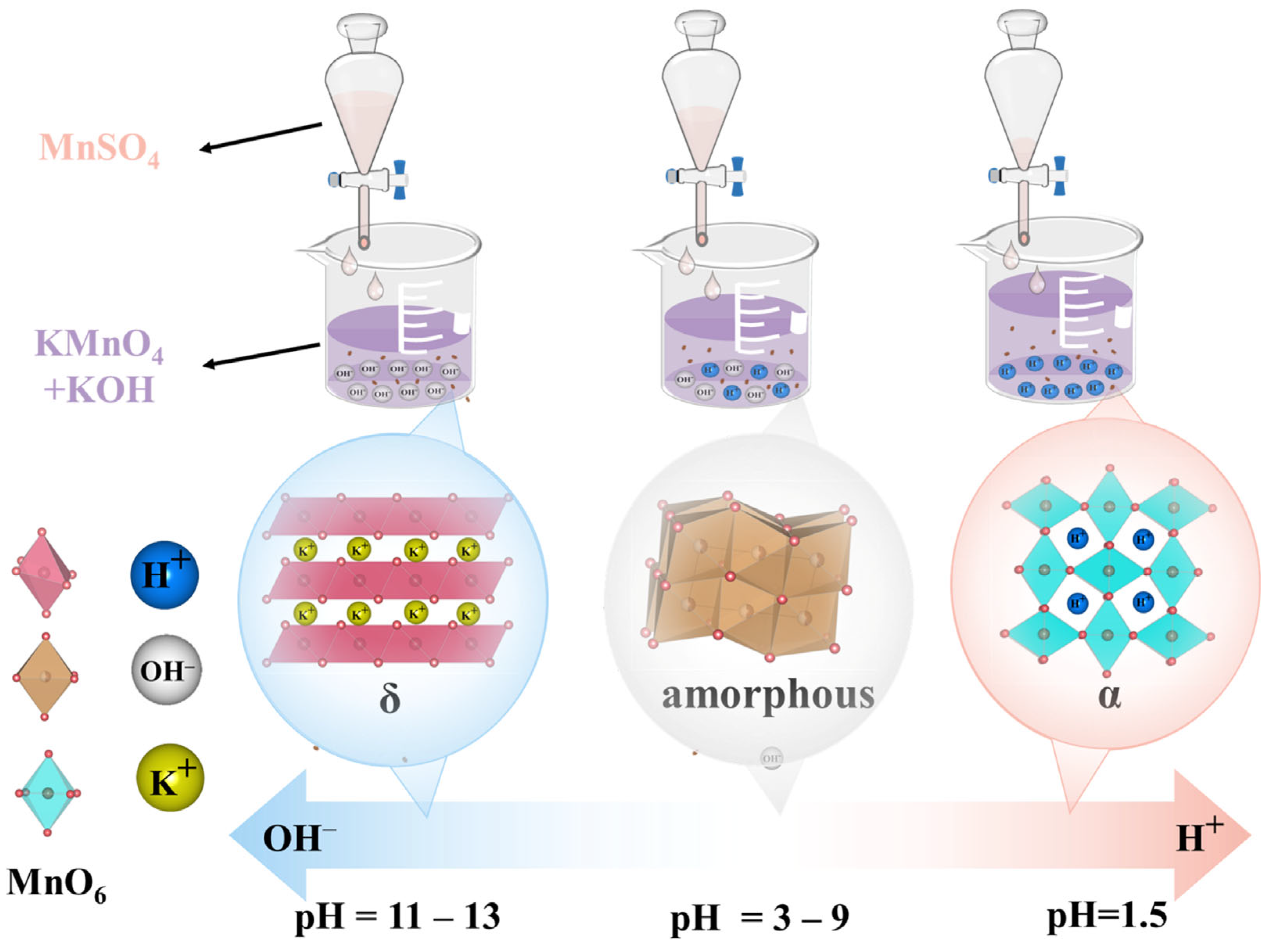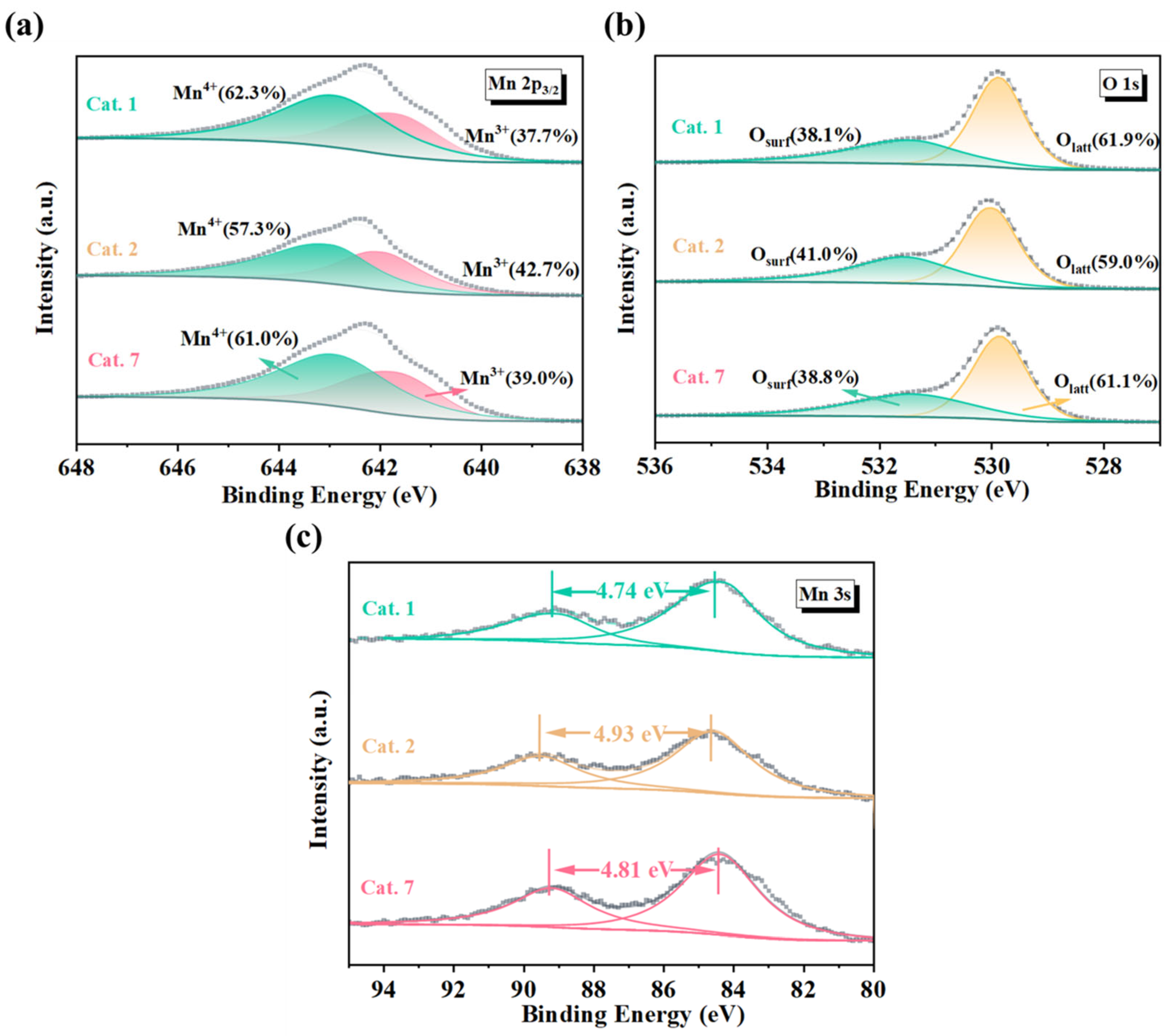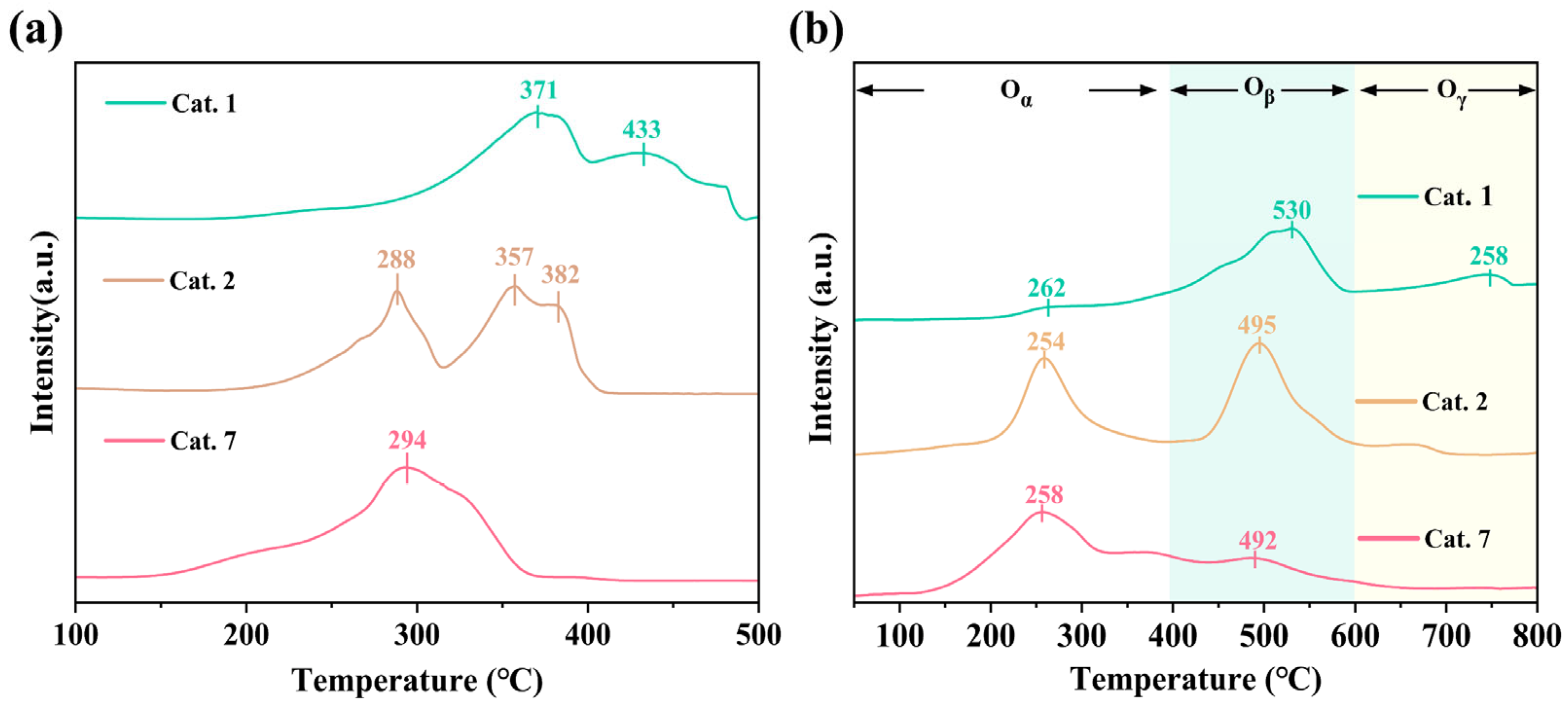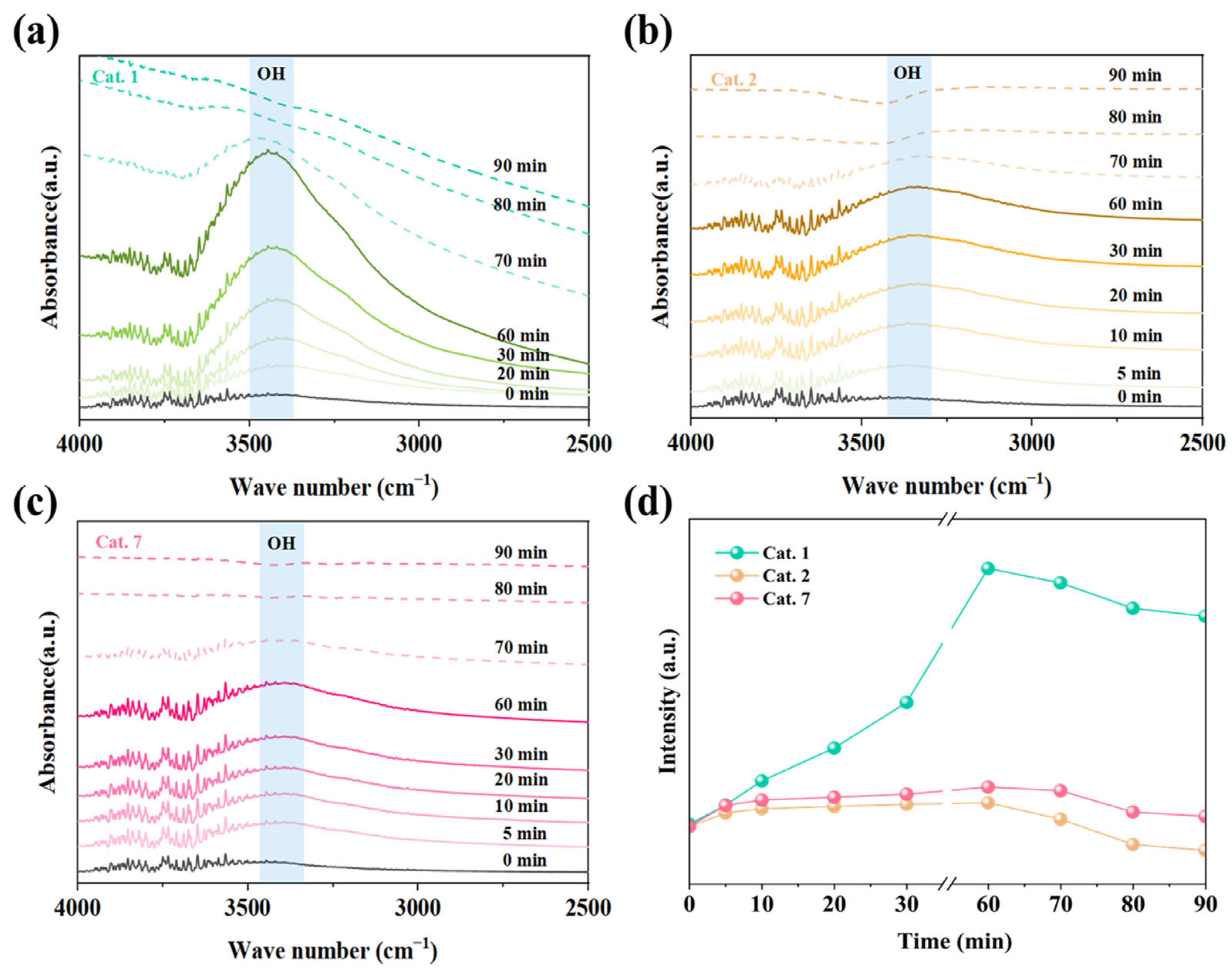Synthesis of MnO2 with Different Crystal Phases via Adjusting pH for Ozone Decomposition Under Various Humidity Conditions and Monolithic Catalyst Development
Abstract
:1. Introduction
2. Results and Discussion
2.1. The Formation Mechanism and Morphological Structure Characterization of the Different MnO2 Phase via pH Adjustment
2.2. Surface Oxidation State and Oxygen Vacancies of the Different MnO2 Phases
2.3. The Behavior of Different MnO2 Phases for O3 Decomposition Under Various Conditions
2.4. The Variation of OH Revealed by In Situ Drifts
2.5. The Development and Low-Concentration Ozone Decomposition Performance in an Air Duct of the Monolithic Catalyst
3. Materials and Methods
3.1. Preparation of MnO2 Catalysts
3.2. Characterizations and Measurements
3.3. Evaluation of Activity for Ozone Decomposition
4. Conclusions
Supplementary Materials
Author Contributions
Funding
Data Availability Statement
Conflicts of Interest
References
- Stenke, A. Natural Control on Ozone Pollution. Nat. Clim. Change 2020, 10, 101–102. [Google Scholar] [CrossRef]
- Hewitt, C.N.; MacKenzie, A.R.; Di Carlo, P.; Di Marco, C.F.; Dorsey, J.R.; Evans, M.; Fowler, D.; Gallagher, M.W.; Hopkins, J.R.; Jones, C.E.; et al. Nitrogen Management Is Essential to Prevent Tropical Oil Palm Plantations from Causing Ground-Level Ozone Pollution. Proc. Natl. Acad. Sci. USA 2009, 106, 18447–18451. [Google Scholar] [CrossRef] [PubMed]
- Ji, J.; Xu, Y.; Huang, H.; He, M.; Liu, S.; Liu, G.; Xie, R.; Feng, Q.; Shu, Y.; Zhan, Y.; et al. Mesoporous TiO2 under VUV Irradiation: Enhanced Photocatalytic Oxidation for VOCs Degradation at Room Temperature. Chem. Eng. J. 2017, 327, 490–499. [Google Scholar] [CrossRef]
- Chen, Y.; Wang, M.; Yao, Y.; Zeng, C.; Zhang, W.; Yan, H.; Gao, P.; Fan, L.; Ye, D. Research on the Ozone Formation Sensitivity Indicator of Four Urban Agglomerations of China Using Ozone Monitoring Instrument (OMI) Satellite Data and Ground-Based Measurements. Sci. Total Environ. 2023, 869, 161679. [Google Scholar] [CrossRef] [PubMed]
- Wu, R.; Agathokleous, E.; Yung, D.H.Y.; Tai, A.P.K.; Shang, B.; Feng, Z. Joint Impacts of Ozone Pollution and Climate Change on Yields of Chinese Winter Wheat. Atmos. Pollut. Res. 2022, 13, 101509. [Google Scholar] [CrossRef]
- Valavanidis, A.; Vlachogianni, T.; Fiotakis, K.; Loridas, S. Pulmonary Oxidative Stress, Inflammation and Cancer: Respirable Particulate Matter, Fibrous Dusts and Ozone as Major Causes of Lung Carcinogenesis through Reactive Oxygen Species Mechanisms. Int. J. Environ. Res. Public Health 2013, 10, 3886–3907. [Google Scholar] [CrossRef]
- Li, M.; Dong, H.; Wang, B.; Zhao, W.; Zare Sakhvidi, M.J.; Li, L.; Lin, G.; Yang, J. Association between Ambient Ozone Pollution and Mortality from a Spectrum of Causes in Guangzhou, China. Sci. Total Environ. 2021, 754, 142110. [Google Scholar] [CrossRef]
- Meo, S.A.; Almutairi, F.J.; Abukhalaf, A.A.; Alessa, O.M.; Al-Khlaiwi, T.; Meo, A.S. Sandstorm and Its Effect on Particulate Matter PM 2.5, Carbon Monoxide, Nitrogen Dioxide, Ozone Pollutants and SARS-CoV-2 Cases and Deaths. Sci. Total Environ. 2021, 795, 148764. [Google Scholar] [CrossRef]
- Sicard, P.; Agathokleous, E.; Anenberg, S.C.; De Marco, A.; Paoletti, E.; Calatayud, V. Trends in Urban air Pollution over the Last Two Decades: A global Perspective. Sci. Total Environ. 2023, 858, 160064. [Google Scholar] [CrossRef]
- Wang, H.; He, C.; Morawska, L.; McGarry, P.; Johnson, G. Ozone-Initiated Particle Formation, Particle Aging, and Precursors in a Laser Printer. Environ. Sci. Technol. 2012, 46, 704–712. [Google Scholar] [CrossRef]
- Fadeyi, M.O. Ozone in Indoor Environments: Research Progress in the Past 15 Years. Sustain. Cities Soc. 2015, 18, 78–94. [Google Scholar] [CrossRef]
- Ma, J.; Cao, R.; Dang, Y.; Wang, J. A Recent Progress of Room–Temperature Airborne Ozone Decomposition Catalysts. Chin. Chem. Lett. 2021, 32, 2985–2993. [Google Scholar] [CrossRef]
- Namdari, M.; Lee, C.-S.; Haghighat, F. Active Ozone Removal Technologies for a Safe Indoor Environment: A Comprehensive Review. Build. Environ. 2021, 187, 107370. [Google Scholar] [CrossRef]
- Li, X.; He, G.; Ma, J.; Shao, X.; Chen, Y.; He, H. Boosting the Dispersity of Metallic Ag Nanoparticles and Ozone Decomposition Performance of Ag-Mn Catalysts Via Manganese Vacancy-Dependent Metal–Support Interactions. Environ. Sci. Technol. 2021, 55, 16143–16152. [Google Scholar] [CrossRef] [PubMed]
- Zhang, M.; Zhang, S.; Wang, Z.; Hu, J.; Lian, Z.; Zhong, Q. Enhanced Water Resistance Mechanism in Ag-Hollandite for Catalytic Ozone Decomposition. J. Hazard. Mater. 2024, 465, 133481. [Google Scholar] [CrossRef]
- Hao, Z.; Cheng, D.; Guo, Y.; Liang, Y. Supported Gold Catalysts Used for Ozone Decomposition and Simultaneous Elimination of Ozone and Carbon Monoxide at Ambient Temperature. Appl. Catal. B Environ. 2001, 33, 217–222. [Google Scholar] [CrossRef]
- Chang, C.-L.; Tser-Sheng, L. Pt/Rh and Pd/Rh Catalysts Used for Ozone Decomposition and Simultaneous Elimination of Ozone and Carbon Monoxide. React. Kinet. Catal. Lett. 2005, 86, 91–98. [Google Scholar] [CrossRef]
- Dong, C.; Yang, J.-J.; Xie, L.-H.; Cui, G.; Fang, W.-H.; Li, J.-R. Catalytic Ozone Decomposition and Adsorptive VOCs Removal in Bimetallic Metal-Organic Frameworks. Nat. Commun. 2022, 13, 4991. [Google Scholar]
- Gong, S.; Wu, X.; Zhang, J.; Han, N.; Chen, Y. Facile Solution Synthesis of Cu2O–CuO–Cu(OH)2 Hierarchical Nanostructures for Effective Catalytic Ozone Decomposition. CrystEngComm 2018, 20, 3096–3104. [Google Scholar] [CrossRef]
- Ma, S.; Ye, X.; Jiang, X.; Cen, W.; Jiang, W.; Wang, H. First Principles Calculation of Mechanical, Dynamical and Thermodynamic Properties of MnO2 with Four Crystal Phases. J. Alloys Compd. 2021, 852, 157007. [Google Scholar] [CrossRef]
- Yang, J.; Ren, S.; Su, B.; Zhou, Y.; Hu, G.; Jiang, L.; Cao, J.; Liu, W.; Yao, L.; Kong, M.; et al. Insight into N2O Formation over Different Crystal Phases of MnO2 during Low-Temperature NH3–SCR of NO. Catal. Lett. 2021, 151, 2964–2971. [Google Scholar] [CrossRef]
- Zhou, C.; Wang, J.; Liu, X.; Chen, F.; Di, Y.; Gao, S.; Shi, Q. Magnetic and Thermodynamic Properties of α, β, γ and δ-MnO2. New J. Chem. 2018, 42, 8400–8407. [Google Scholar] [CrossRef]
- Xu, B.; Qin, H.; Wu, X.; Sun, Y. Ozone Decomposition Mechanism at Different Structural Oxygen Vacancies on Manganese Dioxide. J. Phys. Chem. C 2022, 126, 17076–17083. [Google Scholar] [CrossRef]
- Jia, J.; Zhang, P.; Chen, L. Catalytic Decomposition of Gaseous Ozone over Manganese Dioxides with Different Crystal Structures. Appl. Catal. B Environ. 2016, 189, 210–218. [Google Scholar] [CrossRef]
- Yang, R.; Guo, Z.; Cai, L.; Zhu, R.; Fan, Y.; Zhang, Y.; Han, P.; Zhang, W.; Zhu, X.; Zhao, Q.; et al. Investigation into the Phase–Activity Relationship of MnO2 Nanomaterials toward Ozone-Assisted Catalytic Oxidation of Toluene. Small 2021, 17, 2103052. [Google Scholar] [CrossRef]
- Zhang, J.; Li, Y.; Wang, L.; Zhang, C.; He, H. Catalytic Oxidation of Formaldehyde over Manganese Oxides with Different Crystal Structures. Catal. Sci. Technol. 2015, 5, 2305–2313. [Google Scholar] [CrossRef]
- Li, W.; Gibbs, G.V.; Oyama, S.T. Mechanism of Ozone Decomposition on a Manganese Oxide Catalyst. 1. In Situ Raman Spectroscopy and Ab Initio Molecular Orbital Calculations. J. Am. Chem. Soc. 1998, 120, 9041–9046. [Google Scholar] [CrossRef]
- Ma, J.; Li, X.; Zhang, C.; Ma, Q.; He, H. Novel CeMnaOx Catalyst for Highly Efficient Catalytic Decomposition of Ozone. Appl. Catal. B Environ. 2020, 264, 118498. [Google Scholar] [CrossRef]
- Cao, Z.; Bian, H.; Xie, Z.; Ji, L.; Zhang, Q. Research and improvement on the performance of Ti modified Mn based catalysts for removing ozone at room temperature. J. Guizhou Norm. Univ. (Nat. Sci.) 2024, 42, 75–83. [Google Scholar] [CrossRef]
- Xie, Z.; Ji, L.; Bian, H.; Zhang, Q. Generation of Abundant Oxygen Vacancies in Sandwich Structured ε-MnO2/γ-Al2O3/Al by a Facile Modification Strategy for Enhanced Catalytic Decomposition of Ozone in Humid Conditions. Chem. Eng. J. 2025, 509, 161202. [Google Scholar] [CrossRef]
- Yang, Q.; Li, J.; Wang, D.; Peng, Y.; Ma, Y. Activity Improvement of Acid Treatment on LaFeO3 Catalyst for CO Oxidation. Catal. Today 2021, 376, 205–210. [Google Scholar] [CrossRef]
- Dang, H.; Zhao, W.; Wu, R.; Yue, L.; Wang, Y.; Ren, Z.; Zhao, Y. Effect of Acid Treatment on the Catalytic Performance of CuO/Cryptomelane Catalyst for CO Preferential Oxidation in H2-Rich Streams. Int. J. Hydrogen Energy 2023, 48, 27619–27630. [Google Scholar] [CrossRef]
- Xiong, S.; Zhang, K.; Xu, Z.; Ou, H.; Zheng, Y.; Li, X.; Peng, Y.; Luo, X.; Li, J. Enhancing Ozone Catalytic Decomposition through Acid Treatment of α-MnO2 for Improved Activity and Humidity Resistance. J. Environ. Sci. 2025, 149, 35–45. [Google Scholar] [CrossRef]
- Li, X.; Ma, J.; He, H. Recent Advances in Catalytic Decomposition of Ozone. J. Environ. Sci. 2020, 94, 14–31. [Google Scholar] [CrossRef]
- Liu, S.; Ji, J.; Yu, Y.; Huang, H. Facile Synthesis of Amorphous Mesoporous Manganese Oxides for Efficient Catalytic Decomposition of Ozone. Catal. Sci. Technol. 2018, 8, 4264–4273. [Google Scholar] [CrossRef]
- Zhao, H.; Wang, A.; Zhang, Q.; Han, C. Highly Efficient Removal of Ozone by Amorphous Manganese Oxides Synthesized with a Simple Hydrothermal Method. J. Environ. Sci. 2023, 134, 96–107. [Google Scholar] [CrossRef]
- Yu, Y.; Liu, S.; Ji, J.; Huang, H. Amorphous MnO2 Surviving Calcination: An Efficient Catalyst for Ozone Decomposition. Catal. Sci. Technol. 2019, 9, 5090–5099. [Google Scholar] [CrossRef]
- Yan, Q.; Ji, J.; Chen, Y.; Zhao, G.; Jia, B.; Xu, L.; Cheng, P. By-Product Reduction for the Non-Thermal Plasma Removal of Toluene Using an α-MnO2/Cordierite Honeycomb Monolithic Catalyst in a Honeycomb Structure. Appl. Catal. B Environ. 2024, 343, 123530. [Google Scholar] [CrossRef]
- Chernykh, M.; Grabchenko, M.; Knyazev, A.; Mamontov, G. Cordierite-Supported Transition-Metal-Oxide-Based Catalysts for Ozone Decomposition. Crystals 2023, 13, 1674. [Google Scholar] [CrossRef]
- Cao, R.; Zhang, P.; Liu, Y.; Zheng, X. Ammonium-Treated Birnessite-Type MnO2 to Increase Oxygen Vacancies and Surface Acidity for Stably Decomposing Ozone in Humid Condition. Appl. Surf. Sci. 2019, 495, 143607. [Google Scholar] [CrossRef]
- He, Y.; Zhang, P.; Yang, J.; Wang, S.; Li, J. Fabrication of MnO2 Coating on Aluminum Honeycomb for Fast Catalytic Decomposition of Ozone at Room Temperature. J. Environ. Sci. 2023, 134, 34–43. [Google Scholar] [CrossRef]
- Devaraj, S.; Munichandraiah, N. Effect of Crystallographic Structure of MnO2 on Its Electrochemical Capacitance Properties. J. Phys. Chem. C 2008, 112, 4406–4417. [Google Scholar] [CrossRef]
- Yu, H.; Yang, J.; Lu, L.; Guo, Y.; Guan, J.; Fan, G.; Zhu, Q.; Han, N.; Chen, Y. Controllable Synthesis of Different MnO2 Phases by a Precipitation Method for Effective Ozone Decomposition. J. Phys. Chem. C 2024, 128, 5559–5567. [Google Scholar] [CrossRef]
- McKenzie, R.M. The Synthesis of Birnessite, Cryptomelane, and Some Other Oxides and Hydroxides of Manganese. Mineral. Mag. 1971, 38, 493–502. [Google Scholar] [CrossRef]
- Ji, J.; Lu, X.; Chen, C.; He, M.; Huang, H. Potassium-Modulated δ-MnO2 as Robust Catalysts for Formaldehyde Oxidation at Room Temperature. Appl. Catal. B Environ. 2020, 260, 118210. [Google Scholar] [CrossRef]
- Liu, Y.; Zhang, P. Catalytic Decomposition of Gaseous Ozone over Todorokite-Type Manganese Dioxides at Room Temperature: Effects of Cerium Modification. Appl. Catal. A Gen. 2017, 530, 102–110. [Google Scholar] [CrossRef]
- Yang, Y.; Jia, J.; Liu, Y.; Zhang, P. The Effect of Tungsten Doping on the Catalytic Activity of α-MnO2 Nanomaterial for Ozone Decomposition under Humid Condition. Appl. Catal. A Gen. 2018, 562, 132–141. [Google Scholar] [CrossRef]
- Fang, R.; Feng, Q.; Huang, H.; Ji, J.; He, M.; Zhan, Y.; Liu, B.; Leung, D.Y.C. Effect of K+ Ions on Efficient Room-Temperature Degradation of Formaldehyde over MnO2 Catalysts. Catal. Today 2019, 327, 154–160. [Google Scholar] [CrossRef]
- Wu, Z.; Zhang, P.; Rong, S.; Jia, J. Creating Water-Resistant Oxygen Vacancies in δ-MnO2 by Chlorine Introduction for Catalytic Ozone Decomposition at Ambient Temperature. Appl. Catal. B Environ. 2023, 335, 122900. [Google Scholar] [CrossRef]
- Liu, Y.; Zhang, P. Removing Surface Hydroxyl Groups of Ce-Modified MnO2 to Significantly Improve Its Stability for Gaseous Ozone Decomposition. J. Phys. Chem. C 2017, 121, 23488–23497. [Google Scholar] [CrossRef]
- Zhu, G.; Zhu, J.; Jiang, W.; Zhang, Z.; Wang, J.; Zhu, Y.; Zhang, Q. Surface Oxygen Vacancy Induced α-MnO2 Nanofiber for Highly Efficient Ozone Elimination. Appl. Catal. B Environ. 2017, 209, 729–737. [Google Scholar] [CrossRef]
- Tao, L.; Zhao, G.; Chen, P.; Zhang, Z.; Liu, Y.; Lu, Y. High-Performance Co-MnOx Composite Oxide Catalyst Structured onto Al-Fiber Felt for High-Throughput O3 Decomposition. ChemCatChem 2019, 11, 1131–1142. [Google Scholar] [CrossRef]
- Liang, H.; Wang, X.; Wang, H.; Qu, Z. Co-Doped Cryptomelane-Type Manganese Oxide in Situ Grown on a Nickel Foam Substrate for High Humidity Ozone Decomposition. J. Environ. Sci. 2025, 148, 529–540. [Google Scholar] [CrossRef]
- Govender, S.; Friedrich, H. Monoliths: A Review of the Basics, Preparation Methods and Their Relevance to Oxidation. Catalysts 2017, 7, 62. [Google Scholar] [CrossRef]
- Cao, R.; Li, L.; Zhang, P.; Gao, L.; Rong, S. Regulating Oxygen Vacancies in Ultrathin δ-MnO2 Nanosheets With Superior Activity for Gaseous Ozone Decomposition. Environ. Sci. Nano 2021, 8, 1628–1641. [Google Scholar]
- Wang, A.; Zhao, H.; Wu, Y.; Zhang, Q.; Han, C. Cerium-Modified Amorphous Manganese Oxides for Efficient Catalytic Removal of Ozone. J. Environ. Sci. 2023, 131, 151–161. [Google Scholar]
- Liu, B.; Yi, Z.; Yang, Y.; Li, Y.; Yang, J.; Zhu, M. Unlocking Efficient and Robust Ozone Decomposition with CNT-Confined Manganese Oxide via Synergistic Electronic Modulation. Appl. Catal. B Environ. 2023, 334, 122788. [Google Scholar]
- Zhang, B.; Ji, J.; Liu, B.; Zhang, D.; Liu, S.; Huang, H. Highly Efficient Ozone Decomposition Against Harsh Environments Over Long-Term Stable Amorphous MnOx Catalysts. Appl. Catal. B Environ. 2022, 315, 121552. [Google Scholar]
- Liu, S.; Dai, W.; Liu, B.; Lin, S.; Zeng, F.; Huang, Q.; Sun, M.; Feng, F.; Lan, B.; Huang, H. Highly c-Disordered Birnessite with Abundant out-of-Layer Oxygen Vacancies for Enhanced Ozone Catalytic Decomposition. Separation and Purification Technology 2023, 322, 124254. [Google Scholar]
- Xu, Z.; Yang, W.; Si, W.; Chen, J.; Peng, Y.; Li, J. A novel γ-like MnO2 Catalyst for Ozone Decomposition in High Humidity Conditions. J. Hazar. Mater. 2021, 420, 126641. [Google Scholar]
- Cao, R.; Li, L.; Zhang, P. Macroporous MnO2-based Aerogel Crosslinked with Cellulose Nanofibers for Efficient Ozone Removal Under Humid Condition. J. Hazar. Mater. 2021, 407, 124793. [Google Scholar]
- Deng, Z.; Tian, J.; Wang, P.; Liu, B.; Guo, Y.; Xu, X.; Zeng, Z.; Li, L. Nanoflower-like δ-MnO2 Exhibits Excellent Ozone Decomposition Under Harsh Conditions: The Influence of Potassium ion. Appl. Surf. Sci. 2024, 671, 160769. [Google Scholar] [CrossRef]
- Wang, Z.; Li, T.; Zhang, S.; Zhang, R.; Zhang, Y.; Zhong, Q. One-step Synthesis of δ-MnO2 with Rich Defects for Efficient Ozone Decomposition Under Humid Conditions. J. Chem. Eng. 2024, 488, 150693. [Google Scholar]











| #. | Catalyst | pH 1 | Crystal Structure |
|---|---|---|---|
| 1 * | Cat. 1 | 1.5 | α-MnO2 |
| 2 * | Cat. 2 | 3 | amorphous |
| 3 | Cat. 3 | 5 | amorphous |
| 4 | Cat. 4 | 7 | amorphous |
| 5 | Cat. 5 | 9 | amorphous |
| 6 | Cat. 6 | 11 | δ-MnO2 |
| 7 * | Cat. 7 | 13 | δ-MnO2 |
| Catalyst | Crystal Structure | SBET | Vpore | Dpore |
|---|---|---|---|---|
| (m2·g–1) | (mL·g–1) | (nm) | ||
| Cat. 1 | α-MnO2 | 68.8 ± 2.3 | 0.34 ± 0.02 | 18.23 ± 0.6 |
| Cat. 2 | amorphous-MnO2 | 215.6 ± 4.7 | 0.51 ± 0.03 | 11.75 ± 0.3 |
| Cat. 7 | δ-MnO2 | 133.6 ± 3.2 | 0.63 ± 0.04 | 17.27 ± 0.5 |
| Catalysts | Mn 2p3/2 | Mn 3s | O 1s | ||||
|---|---|---|---|---|---|---|---|
| Mn4+ % | Mn3+ % | Mn3+/Mn4+ % | AOS of Mn | Olatt % | Osurf % | Osurf/Olatt | |
| Cat. 1 | 62.3 ± 1.8 | 37.7 ± 1.2 | 0.61 | 3.62 | 61.9 ± 1.5 | 38.1 ± 0.8 | 0.62 |
| Cat. 2 | 57.3 ± 1.6 | 42.7 ± 1.5 | 0.75 | 3.40 | 59.0 ± 1.4 | 41.0 ± 0.9 | 0.69 |
| Cat. 7 | 61.0 ± 1.7 | 39.0 ± 1.3 | 0.64 | 3.54 | 61.1 ± 1.3 | 38.8 ± 0.9 | 0.64 |
Disclaimer/Publisher’s Note: The statements, opinions and data contained in all publications are solely those of the individual author(s) and contributor(s) and not of MDPI and/or the editor(s). MDPI and/or the editor(s) disclaim responsibility for any injury to people or property resulting from any ideas, methods, instructions or products referred to in the content. |
© 2025 by the authors. Licensee MDPI, Basel, Switzerland. This article is an open access article distributed under the terms and conditions of the Creative Commons Attribution (CC BY) license (https://creativecommons.org/licenses/by/4.0/).
Share and Cite
Bian, H.; Xie, Z.; Zhang, Q. Synthesis of MnO2 with Different Crystal Phases via Adjusting pH for Ozone Decomposition Under Various Humidity Conditions and Monolithic Catalyst Development. Catalysts 2025, 15, 290. https://doi.org/10.3390/catal15030290
Bian H, Xie Z, Zhang Q. Synthesis of MnO2 with Different Crystal Phases via Adjusting pH for Ozone Decomposition Under Various Humidity Conditions and Monolithic Catalyst Development. Catalysts. 2025; 15(3):290. https://doi.org/10.3390/catal15030290
Chicago/Turabian StyleBian, Haoran, Zukun Xie, and Qi Zhang. 2025. "Synthesis of MnO2 with Different Crystal Phases via Adjusting pH for Ozone Decomposition Under Various Humidity Conditions and Monolithic Catalyst Development" Catalysts 15, no. 3: 290. https://doi.org/10.3390/catal15030290
APA StyleBian, H., Xie, Z., & Zhang, Q. (2025). Synthesis of MnO2 with Different Crystal Phases via Adjusting pH for Ozone Decomposition Under Various Humidity Conditions and Monolithic Catalyst Development. Catalysts, 15(3), 290. https://doi.org/10.3390/catal15030290







